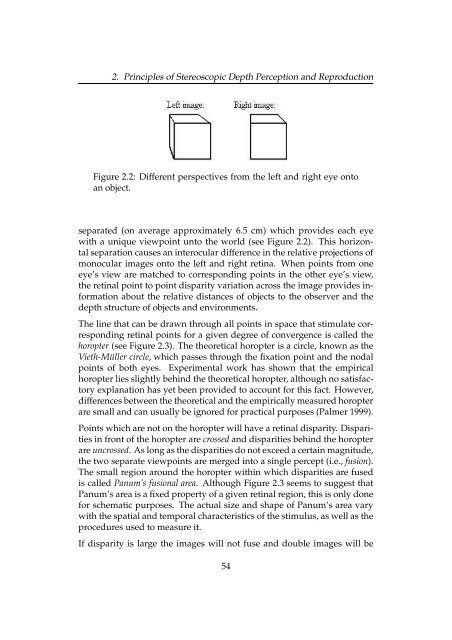Chapter 2 Principles of Stereoscopic Depth Perception and ...
Chapter 2 Principles of Stereoscopic Depth Perception and ...
Chapter 2 Principles of Stereoscopic Depth Perception and ...
Create successful ePaper yourself
Turn your PDF publications into a flip-book with our unique Google optimized e-Paper software.
2. <strong>Principles</strong> <strong>of</strong> <strong>Stereoscopic</strong> <strong>Depth</strong> <strong>Perception</strong> <strong>and</strong> Reproduction<br />
Figure 2.2: Different perspectives from the left <strong>and</strong> right eye onto<br />
an object.<br />
separated (on average approximately 6.5 cm) which provides each eye<br />
with a unique viewpoint unto the world (see Figure 2.2). This horizontal<br />
separation causes an interocular difference in the relative projections <strong>of</strong><br />
monocular images onto the left <strong>and</strong> right retina. When points from one<br />
eye’s view are matched to corresponding points in the other eye’s view,<br />
the retinal point to point disparity variation across the image provides information<br />
about the relative distances <strong>of</strong> objects to the observer <strong>and</strong> the<br />
depth structure <strong>of</strong> objects <strong>and</strong> environments.<br />
The line that can be drawn through all points in space that stimulate corresponding<br />
retinal points for a given degree <strong>of</strong> convergence is called the<br />
horopter (see Figure 2.3). The theoretical horopter is a circle, known as the<br />
Vieth-Müller circle, which passes through the fixation point <strong>and</strong> the nodal<br />
points <strong>of</strong> both eyes. Experimental work has shown that the empirical<br />
horopter lies slightly behind the theoretical horopter, although no satisfactory<br />
explanation has yet been provided to account for this fact. However,<br />
differences between the theoretical <strong>and</strong> the empirically measured horopter<br />
are small <strong>and</strong> can usually be ignored for practical purposes (Palmer 1999).<br />
Points which are not on the horopter will have a retinal disparity. Disparities<br />
in front <strong>of</strong> the horopter are crossed <strong>and</strong> disparities behind the horopter<br />
are uncrossed. As long as the disparities do not exceed a certain magnitude,<br />
the two separate viewpoints are merged into a single percept (i.e., fusion).<br />
The small region around the horopter within which disparities are fused<br />
is called Panum’s fusional area. Although Figure 2.3 seems to suggest that<br />
Panum’s area is a fixed property <strong>of</strong> a given retinal region, this is only done<br />
for schematic purposes. The actual size <strong>and</strong> shape <strong>of</strong> Panum’s area vary<br />
with the spatial <strong>and</strong> temporal characteristics <strong>of</strong> the stimulus, as well as the<br />
procedures used to measure it.<br />
If disparity is large the images will not fuse <strong>and</strong> double images will be<br />
54


